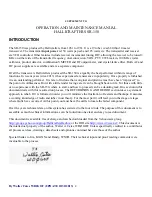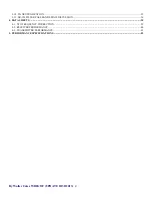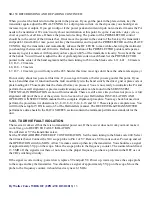
By Walter Cates WD0GOF (UPDATE 10/30/2013)
9
SR-150 REFURBISHING AND REPAIRING CONTINUED:
1-7. RECEIVER TESTING
All of the receiver testing will be accomplished by performing tests outlined in the RECEIVER FAULT
ISOLATION section. The Hallicrafters spec states the receiver sensitivity as 1uv signal in for 20db signal plus
noise to noise. The gain is specified at 1uv in for ½ watt audio output. It is quite common for the SR-150 to
meet both of these specs at 0.5uv. I have seen quite a number achieve spec at 0.2uv.
1-8. RECEIVER FAULT ISOLATION
1-8-1. EQUIPMENT REQUIRED:
HF RF signal generator capable of 0.5 microvolts to 300 millivolts and covering 1600 KHZ to 7.3 MHZ Audio
output meter (similar to General Radio 1840A).
Scope 100 MHZ or better with 1:1 and 10:1 probes or switchable probe.
Audio oscillator with 600 ohm output Z
0
capable of from 0.7 millivolts to 15v peak to peak output.
1-8-2. RX FAULT ISOLATION PROCEDURE:
There is not anything inherently clever about this process. What it does offer is signal injection levels and
output results gathered from dozens of tests performed on SR-150’s over 12 years. For those who wish to
expound on the evil effects of probe loading and ckt miss-matches, I concede you are correct, it does happen.
But the process works, it is repeatable and simple to follow. Throughout this process we will be injecting
signals at different points throughout the radio and monitoring the audio output from the receiver. In all cases
the output we are looking for is 1 watt of audio output. It is recommended to use an audio output meter. This is
helpful because audio output meters similar the GR 1840A allows for dB measurements as well as power
output. Any 10 watt resistive load may be used in place of the audio power meter. When using an alternative
load you will need to monitor the voltage across the load. Then you will have to convert the RMS or peak to
peak voltage to watts depending upon your use of a scope or RMS voltmeter.
Read the entire procedure thru before you start.
To eliminate problems caused by the AGC install a clip
lead from the tie point of R20, 220k and R116 820k and ground. These resistors are located on the 4 lug
terminal strip adjacent to the socket of V17. Set up the receiver on the 40 meter band at 7.3 MHz. Adjust the RF
GAIN and AF GAIN to max. This process is written specifically for resurrecting long dead rigs. Multiple faults
are assumed.
Note; There were 7 production runs of the SR-150. The following signal
levels apply directly to runs 3 through 7. Production runs 1 and 2 will
require as much as 10% more signal for the same audio output levels.
Refer to SECTION-2 for details to determine which production level you
have. IT IS HIGHLY RECOMMENDED TO UPGRADE TO LEVEL 7.
Summary of Contents for SR-150
Page 18: ...By Walter Cates WD0GOF UPDATE 10 30 2013 18...
Page 19: ...By Walter Cates WD0GOF UPDATE 10 30 2013 19 BEFORE CLEANING CLEAN CHASSIS...
Page 20: ...By Walter Cates WD0GOF UPDATE 10 30 2013 20 3 1 2 TUBE SOCKET CLEANING KIT...
Page 21: ...By Walter Cates WD0GOF UPDATE 10 30 2013 21 3 1 3 AIR VARIABLE CLEANING...
Page 30: ...By Walter Cates WD0GOF UPDATE 10 30 2013 30 3 5 5 K3 WIRING AND PIN OUT...
Page 38: ...By Walter Cates WD0GOF UPDATE 10 30 2013 38 4 DATA SHEETS...










































